Here's What the Hiring Manager's Actually Looking For in That (Dreaded) Take-Home Assignment

Just when you think the you’ve nailed your interview, you hear this dreaded line:
As the next step in the process, we’d like for you to complete a short take-home assignment.
Suddenly, instead of doing a celebratory dance that you’re one step closer to the position, you’re thinking, “I’d better cancel my dinner plans for tonight, and tomorrow.” Quickly followed by, “Oh no! This is where they find out I’m a complete fraud !”
Before you panic about the assignment that’s standing between you and your dream job, take a deep breath and stop beating yourself up over it. It’s not exactly what you think—seriously, I used to assign them to candidates all the time, so I know.
Here are a couple things you need to understand about what hiring managers are actually looking for in this project.

Don’t Agonize Over Finding the “Right” Answer
If you haven’t been hired yet, you shouldn’t be expected to know all the nitty-gritty details about a company. And hiring managers know this!
Sure, the assignment is a great way for the company to see how you would address a real business problem, but it would be unrealistic to expect even the most qualified candidates to present a solution that could be implemented immediately. Again, I can’t reiterate this enough: The person who assigned this is completely aware of that fact!
And because of this, you shouldn’t stay up late focusing only on getting the “right” answer. Odds are, there isn’t only one right answer.
Depending on your expertise, this might manifest itself in a number of ways. If you’re a programmer who’s being asked to write some sample code, the hiring manager is going to be way more interested in how quickly you identify the mistakes you’ve made. And before you say, “Well, I won’t make any mistakes,” don’t worry, you will. The same goes for those of you who are writers, marketers, or sales people. You will mess up somewhere in the assignment.
When you’re brought in again (fingers crossed) and asked to discuss where you went wrong, be open and willing to find and acknowledge any errors. Bonus points if you can bring quick fixes and solutions to the table as well. One way to prepare for this conversation is to look at your take-home test before going back in to the office—you’ll almost always find a spot you’d like to revise.
Don’t Psych Yourself Out
How many times have you looked at the email outlining the requirements and thought to yourself, “If I can’t do this, how would I possibly excel in the actual job?”
Here’s the thing, though: If you weren’t capable of doing the job, you wouldn’t have been sent home with it in the first place.
In fact, the take-home assignment should actually be a huge boost to your confidence. When you’re asked to complete one, it’s a clear indication that the hiring manager’s excited to see how you’d tackle a problem similar to one the organization’s been dealing with. In other words, the company’s struggled with the issue in the past and would love to hear your input!
Of course, depending on exactly what you’re being asked to complete, you’ll want to take some additional precautions before diving in. But the mere fact that you’re moving to this step is a good indication you’re a top contender.
Keep in mind: The person who will review this assignment’s often juggling multiple calendars, interviews, and never-ending inboxes. No one adds more to his or her plate for fun. You’re in a great place!
Don’t Forget This Is Just as Much for You as it Is for the Hiring Manager
Most job seekers can’t count the number of times they’ve been told they should be interviewing a company as much as a company interviews them. There are a number of reasons for this, but the biggest reason is to make sure you actually want to join the company (how many of us have taken jobs just because we’ve needed them—only to regret it on day one?). However, as tired as you might be of hearing this kind of advice, it also applies to the assignment:
If you find it boring or not suited for your skills, don’t ignore this.
While it won’t be completely indicative of what your day-to-day will be like, many elements of it are probably pretty close. It’s OK if it’s challenging, but it’s not OK if you’re miserable from the minute you start it.
Back in my recruiting days, I worked with each hiring manager to develop take-home assignments that would give us clarity on whether or not a candidate would thrive in similar challenges. We didn’t always expect people to nail the assignment. In fact, in some cases, we liked a candidate so much, we just wanted to make sure he or she met our deadline. But, we did try to give the person an idea of what to expect. If that doesn’t line up for what you’re hoping to do in your next role, take that into consideration, especially if you’re ultimately offered the job.
Yes, an interview assignment can be daunting, but it’s nothing to lose your mind over. Take a deep breath, remind yourself that you can do this, and remember that while it’s an important piece of your candidacy, it’s not the only piece. You’ve gotten this far—now you only have a little bit longer to go.
Photo of stressed worker courtesy of Shutterstock .
- Book a Speaker
Lorem ipsum dolor sit amet, consectetur adipiscing elit. Vivamus convallis sem tellus, vitae egestas felis vestibule ut.
Error message details.
Reuse Permissions
Request permission to republish or redistribute SHRM content and materials.
Pros and Cons of Tests and Take-Home Assignments in Recruiting

The hiring process can be long, costly and fraught with opportunities to make the wrong choice. To combat this possibility, some companies turn to various types of objective assessments of potential candidates, including tests and take-home assignments.
Testing can be a slippery slope, though. Some potential employees balk at these assessments. HR leaders need to ensure that the tests they're using are valid and reliable, meaning they are accurate assessments of specific traits and competencies. But it may be difficult to determine if the applicants are taking the tests on their own or seeking help from others.
[SHRM members-only toolkit: Recruiting Internally and Externally ]
Testing Can Minimize the Risk of Making the Wrong Choice
Tests and take-home assignments can lend some reliability to what can often be a very subjective hiring process.
"Interviewing is the least statistically correlated method of predicting success on the job, and yet it is often used exclusively by many companies to make hiring decisions," said Susan Hosage, who added she has been "on the giving and receiving end of pre-employment tests for decades." Hosage is a senior consultant and executive coach with OneSource HR Solutions. "Abilities-based tests and profiling offer significant benefits when added to pre-employment screening and interviewing."
Martin Coover, a partner at Jobplex, a recruiting firm based in Chicago, said he has definitely seen an increase in the use of assessments during the hiring process. In the past, he said, these types of assessments were primarily done at the executive level. Today they're likely to be conducted at all levels and across different types of organizations.
"[Testing] is predominately driven by more robust technology and talent acquisition teams wanting to get as much good information as they can before making a hiring decision," Coover said. "I think every company has really done the math on the cost of a bad hire and the cost of losing somebody or having to fire someone and how that can set you back, so there is absolutely a quest to understand a lot more before bringing somebody on."
By using tests to assess job candidates, recruiters can now "remove some of the human bias and get more objective information" when making hiring decisions, Hosage said. "Recruiting has always been a combination of art and science, but now the science is getting better."
Being able to collect data through testing to better inform the hiring decision is a good thing, according to many HR teams and hiring managers. But job candidates may have some objections.
Dealing with Pushback from Candidates
Perhaps one of the biggest drawbacks in using tests and take-home assignments is the risk of getting pushback from candidates. Not all potential hires are enamored of the prospect of taking tests or completing assessments as part of the hiring process. And, in an employee-driven job market, they wield a certain amount of power.
For HR leaders, recruiters and hiring managers, "it's really about the balance between the tight labor market, the amount of opportunities the candidate has and how burdensome the process is for each of those opportunities," Coover said. There are 6.8 million open jobs and 5.8 million people looking for work, according to the U.S. Bureau of Labor Statistics. Employers have to move fast and offer a great candidate experience to stand out from the crowd.
Candidates are busy. The best ones likely have a current full-time job and plenty of other demands on their time. They may be understandably hesitant to take on more work, especially when they're considering multiple potential job opportunities.
In some cases, candidates may also be concerned about employers taking advantage of their knowledge, expertise and intellectual capital. Candidates asked to create detailed marketing plans, for instance, may have concerns if the company will use that input even if they're not chosen for the position.
Coover noted that the disadvantages in using pre-employment tests are not just about candidate pushback, though. "When a candidate is going through the hiring process, the company that can be a little bit more expeditious … will be able to get an offer out quicker. A lot of time, assessments and the time it takes to give those assessments can be a real bottleneck in the process."
The goal for employers, Coover said, is to find the right balance: Get the essential information needed to make a good hiring decision, but do not take up too much of the candidate's time.
Ensuring the Validity of Tests
Do tests really add validity to the hiring process? It depends. Some companies have had their assessments validated, but others haven't. If candidates are allowed to take their assessments home, it's hard to tell if candidates are completing the assessments themselves or seeking help from others.
While tests and assessments can provide important insight, it's important to understand, Coover said, that these results reveal only part of a candidate's qualifications. "It's just one data point," he cautioned, and should be considered in context with all the other information gathered during the hiring process.
Lin Grensing-Pophal is a freelance writer in Chippewa Falls, Wis.
Related Content

Why AI+HI Is Essential to Compliance
HR must always include human intelligence and oversight of AI in decision-making in hiring and firing, a legal expert said at SHRM24. She added that HR can ensure compliance by meeting the strictest AI standards, which will be in Colorado’s upcoming AI law.

A 4-Day Workweek? AI-Fueled Efficiencies Could Make It Happen
The proliferation of artificial intelligence in the workplace, and the ensuing expected increase in productivity and efficiency, could help usher in the four-day workweek, some experts predict.
Advertisement

Artificial Intelligence in the Workplace
An organization run by AI is not a futuristic concept. Such technology is already a part of many workplaces and will continue to shape the labor market and HR. Here's how employers and employees can successfully manage generative AI and other AI-powered systems.
HR Daily Newsletter
News, trends, analysis and breaking news alerts to help HR professionals do their jobs better each business day.
Success title
Success caption
Cracking the Code: Mastering Take-Home Assignments for Product Management Interviews

Navigating a product management interview, especially with the added challenge of a take-home assignment, can indeed be daunting. However, with the right strategies and preparation, you can approach these assignments with confidence and excel. This comprehensive guide aims to provide you with actionable tips and insights to help you tackle your product management interview assignments effectively. From understanding the assignment requirements to organizing your approach and delivering a polished final product, each step of the process will be covered to ensure you are well-equipped to succeed. Whether it's analyzing case studies, presenting solutions, or demonstrating your problem-solving skills, this guide will empower you to showcase your abilities and make a lasting impression on potential employers. So, fear not! With this guide as your companion, you'll be ready to ace your product management interview assignments and take the next step in your career with confidence and poise.
What's the purpose of Take-Home Assignments?
Take-home assignments serve as an integral component of the interview process for companies seeking to assess candidates' suitability for product management roles . These tasks are designed to provide hiring managers with insight into candidates' problem-solving skills, product thinking abilities, and approach to real-world scenarios. By completing the assignment, candidates have the opportunity to showcase their capabilities and demonstrate their thought process in addressing complex challenges. This practical demonstration allows recruiters to gain a deeper understanding of candidates' potential as product managers, beyond what can be gleaned from traditional interviews alone. Ultimately, take-home assignments serve as a valuable tool for evaluating candidates' readiness and suitability for product management roles within the organization.
Let's take a look at 9 key points to remember for you to master Take-Home Assignments:
1. Decoding the Assignment
Deciphering the assignment begins with a meticulous examination of the brief provided. This involves dissecting the problem statement, objectives, evaluation criteria, and the anticipated deliverables. Paying heed to any specific requirements or constraints outlined in the assignment is crucial as they serve as guiding parameters for your approach. Understanding the nuances of the assignment ensures that you embark on the task with clarity and purpose, setting the stage for a well-structured and targeted solution.
2. Time Management is Key
Efficient time management forms the backbone of successful completion of a take-home assignment. Crafting a realistic timeline is paramount, allocating adequate time for each phase of the task, from comprehending the problem to research, brainstorming, execution, and refinement. Prioritizing tasks based on their significance and potential impact on the final output is essential to ensure that no aspect of the assignment is overlooked or rushed. By adhering to a well-planned schedule, you maximize productivity, minimize stress, and optimize the quality of your solution.
3. Research and Immersion
Delivering a compelling solution hinges on immersing yourself in the intricacies of the product domain, target audience, and user personas delineated in the assignment. Thorough research acts as the cornerstone of informed decision-making, providing valuable insights into user needs, market dynamics, competitor landscape, and industry trends. The depth and breadth of your understanding directly influence the strategic soundness and relevance of your solution, making comprehensive research a non-negotiable aspect of the process. By delving deep into the subject matter, you equip yourself with the knowledge and perspective necessary to devise innovative and impactful solutions.
4. Define Your Approach
A well-defined approach serves as the roadmap for navigating the complexities of the assignment and devising a structured solution. Begin by articulating the problem statement succinctly, ensuring a clear understanding of the task at hand. Breaking down the assignment into manageable components facilitates a systematic approach, allowing you to tackle each aspect methodically. Establishing key milestones enables you to track progress, maintain focus, and ensure timely completion of the assignment. By delineating a coherent and strategic approach, you demonstrate your analytical prowess, problem-solving acumen, and ability to navigate complex challenges effectively.
5. Prototype and Iterate
Prototyping serves as a powerful tool for refining and validating your solution iteratively. Don't hesitate to translate your ideas into tangible forms through sketches, wireframes, or basic prototypes. Prototyping enables you to visualize concepts, test hypotheses, and gather feedback early in the process. Iterating on your design allows you to identify and address potential shortcomings, refine features, and fine-tune the user experience. By incorporating user-centric design principles and feedback loops, you enhance the efficacy and usability of your solution, ensuring alignment with user needs and expectations.
6. Presentation Matters
Presenting your solution effectively is as crucial as the solution itself. Structuring your response in a coherent and logical manner ensures that your ideas are conveyed clearly and comprehensively. Utilize visual aids, such as charts, diagrams, and illustrations, to enhance understanding and highlight key insights. Craft a narrative that guides the evaluator through your decision-making process, rationale, and the strategic considerations behind your solution choices. By articulating your thoughts with clarity and precision, you facilitate a deeper understanding of your solution and its potential impact.
7. Seek Feedback
Seeking feedback from mentors, peers, or industry professionals after submitting your assignment can provide valuable perspectives and insights. Constructive feedback helps identify blind spots, areas for improvement, and alternative approaches that you may not have considered. Embrace feedback as a learning opportunity, leveraging it to refine your skills, enhance your approach, and broaden your perspective. Engaging in dialogue with others fosters a culture of continuous improvement and personal growth, positioning you for success in future assignments and professional endeavors.
8. Stay Authentic
While demonstrating your skills and expertise is essential, it's equally important to stay true to your authentic self in your solution. Let your unique perspective, creativity, and passion shine through, as they are valuable assets that set you apart from other candidates. Authenticity fosters genuine connections and resonates with potential employers seeking individuals with integrity, originality, and innovative thinking. By staying authentic, you build trust, credibility, and rapport, laying the foundation for a successful career in product management .
9. Practice, Practice, Practice
Mastering take-home assignments requires consistent practice, refinement, and honing of your skills . Engage in mock assignments, simulate diverse scenarios, and challenge yourself to think critically and creatively. Actively seek opportunities to apply your problem-solving skills and iterate on your approach based on feedback and experience. With each practice session, you'll gain confidence, proficiency, and a deeper understanding of the nuances of product management. Embrace the iterative nature of learning, remain open to experimentation, and commit to continuous improvement to excel in tackling take-home assignments and succeeding in your product management career.
Approaching take-home assignments for product management interviews may seem daunting at first, but with the right mindset, preparation, and strategy, you can excel in showcasing your potential as a product leader. By understanding the purpose of the assignment, managing your time effectively, conducting thorough research, defining a structured approach, and emphasizing presentation and authenticity, you'll be well-equipped to crack the code and impress hiring managers with your innovative solutions.
Explore, Engage, Elevate: Discover Unlimited Stories on Rise Blog
Let us know your email to read this article and many more, plus get fresh jobs delivered to your inbox every week 🎉
Featured Jobs ⭐️
Get Featured ⭐️ jobs delivered straight to your inbox 📬
Get Fresh Jobs Delivered Straight to Your Inbox
Join our newsletter for free job alerts every Monday!

Jump to explore jobs
Sign up for our weekly newsletter of fresh jobs
Get fresh jobs delivered to your inbox every week 🎉
edition e1.0.8
You’re reading an excerpt of The Holloway Guide to Technical Recruiting and Hiring , a book by Osman (Ozzie) Osman and over 45 other contributors. It is the most authoritative resource on growing software engineering teams effectively, written by and for hiring managers, recruiters, interviewers, and candidates. Purchase the book to support the author and the ad-free Holloway reading experience. You get instant digital access, over 800 links and references, commentary and future updates, and a high-quality PDF download.
A take-home assignment (take-home or takehome) is a coding task given to technical candidates to complete on their own time. Candidates are typically given a day to several days to complete a take-home.
controversy Take-homes are controversial. While there are many pros for the companies assigning them, they are less valuable in terms of the candidate experience. Nonetheless, they do have some advantages for candidates.
Benefits of Take-homes
candidate Take-homes remove a lot of the stress associated with onsite challenges. Candidates get to use their own tools and work in the style they would if they were on the job. They can review and iterate on their work, take time away to think or rest, and rewrite. One senior engineer put it this way: “Most employees ‘take home’ their work if you think about it. You get work, you go away and think, you do it, you sleep, you come back and review it. That’s how our jobs work.”
For companies, take-homes have arguably the lowest false negative rate of any interview format—“the truest signal,” as Scott Woody, former Director of Engineering at Dropbox, put it to Holloway. A few factors account for this:
Take-homes give the candidate enough time to do the work in an environment that they’re comfortable with, so you eliminate the noise of a whiteboard interview .
It’s very hard to hide weaknesses in coding ability in a take-home, and follow-up conversations can tell you almost everything you need to know about how a candidate thinks through problems.
Follow-ups also allow you to weed out and correct for any negative signal or false signal—for example, if a candidate cheats, talking through their work will help you figure that out.
Follow-ups are an important part of the take-home evaluation; in this respect, take-homes are the first step of a larger conversation. A good take-home will mimic assignments the candidate might reasonably be asked to do on the job and will give you practical signal on their abilities, creativity, and style.
Here’s how a sample assignment might progress. Let’s say the take-home is something like “Build a simple web-based calculator app” or “Build an AI version of Tetris.” When the candidate returns, you might read the code and interrogate it together, bringing the initial asynchronous assessment into a synchronous evaluation:
You ask the candidate to critique their work.
You may then ask them what they would do given another 20 hours; or say, “How would you invest 10 more hours on this?” Questions like “What feature would you remove?” and “What feature would you add?” will further refine your understanding of their work.
An additional useful question is, “What shortcuts did you take, and why did you think that was the right shortcut?”
Downsides of Take-homes
caution The major downside of take-homes is the time commitment they require. Because the market is so competitive, asking a strong candidate to give up their weekend for a take-home can lead them to drop out of your process. Senior candidates may feel that being asked to do a take-home is a waste of their time. For these reasons, take-homes usually make sense further along in the funnel . They require a lot of engineering time and investment from interviewers and candidates, so they aren’t ideal for screening. Some companies opt to pay candidates for the time they spend on these assignments, but this doesn’t always make a difference. A senior manager at Dropbox told us that before the company pivoted from take-homes, 20% of candidates would simply not complete them. Less-competitive candidates were more likely to complete the assignment, because they didn’t have competing offers. The pass-through rate was close to 10%. If you’re asking candidates to invest 15 hours, and their chance of passing through is 10%, the value asymmetry is strong.
Despite the high signal achieved, interviewers, too, spend hours of their time designing take-homes, scaffolding in multiple languages, and reviewing code, and with such a low pass-through rate, this hardly pays out.
danger The other major con of take-homes is that they explicitly discriminate against people who have families or adverse financial situations, or who work more than one job. If these candidates are in the hiring pipeline at more than one company, they may receive multiple take-home assignments at once, making them impossible to complete, and this may cause the candidates to drop out of your process.
Take-homes also open up the possibility that a candidate may cheat by asking friends to help or collaborate. Additionally, with a take-home, you’re asking candidates to work in a vacuum, which doesn’t match to most work environments, where you’re hopefully able to ask questions and get feedback as you progress.
caution Take-homes are difficult to timebox and thus difficult to assess fairly. If candidates have been given 48 hours to turn in an assignment, you might be comparing candidates who spent 40 hours with those who spent only 2.
One way to avoid this false signal is to pay people an hourly rate for the assignment; but candidates can lie, either saying they worked more hours so as to receive the pay or fewer hours because they want to look impressive.
There are situations in which the pros of take-homes outweigh the cons. Smaller companies may find it easier to assign take-homes than to expend the time and resource investment in a longer pipeline, where multiple interviews would be needed to get the same signal. Younger engineers trying to break into the industry may prefer take-homes because they provide a chance to demonstrate skills they haven’t yet had a chance to prove on the market. If there’s a candidate you haven’t gotten clear signal from yet, adding a take-home to their pipeline will usually tell you one way or another whether the bet will pay off. Scott Woody, former Director of Engineering at Dropbox, told us that people who tend to shine on take-homes have nontraditional backgrounds: “They’re hackers, or they never took CS in college, and they’d fail out of our normal process. But we can see they’ve been doing all this practical work on the side, so let’s give them this practical thing and they’re going to build something singular.”
Take-home Tips
Using a tool like Takehome.io can help with timeboxing take-homes. It might seem like the option of timeboxing would help solve a lot of the cons of this format, but many engineers hold the opinion that time limits introduce further artificiality that compromises what could otherwise be a clear signal. There are tradeoffs any way you approach it.
If you do choose to give take-homes, it’s important to be clear with the candidate that the results will only be used for evaluation and not to produce work for the company. You might also provide an upper bound on the amount of time a candidate should spend on the take-home. When sending candidates the assignment, it’s important to let them know what it is that you will be evaluating—the code? the creativity? the speed? This will help ensure that they don’t waste time on something that won’t translate as much to the assessment and the eventual job. You likely also will want to avoid noting things as nice-to-haves unless they are truly necessary for the assessment.
One idea worth noting to help make the candidate experience better is to replace the take-home with a project that is done in the office during the onsite. Such a project still requires a logistical burden, but has the benefit of feeling like a symmetric exchange of time, particularly if it replaces multiple interview questions. The goal is to mimic the benefits the take-home has for candidates—let them work alone.
candidate Understanding the reasons why a company might choose a take-home problem can help candidates prepare. This guide from Jane Phillips has a host of practical suggestions for tackling take-home coding challenges , along with an FAQ on common scenarios, like needing more time or what to do if you’re not familiar with a language or framework in the take-home problem.
Prior Work Assessment
Some companies choose to ask candidates for past work samples rather than asking them to write code (though you can do both). The nice thing about this approach is that it allows you to see something that the candidate actually did in a real-world setting. However, it can be difficult for many candidates to provide this kind of work sample if they don’t have an open-source presence, and evaluating these work samples may take more time and require a great deal of interviewer effort to evaluate. Prior work assessments can be:
Synchronous. The candidate walks the interviewer through a completed project or portfolio.
Asynchronous. The candidate sends work to the interviewer for them to review, and/or the interviewer reviews the candidate’s open-source projects (likely on GitHub).

- Articles / Homework
Smart Homework: How to Manage & Assess It
by MiddleWeb · Published 08/20/2014 · Updated 12/14/2019
In the first installment of our smart homework series from author & teaching consultant Rick Wormeli, he made the case for take-home assignments that matter for learning and engage student interest . In Part 2 , Rick suggested 13 guiding principles to help teachers create homework challenges that spark deeper learning. In this final article, Rick suggests some good ways to assess homework and manage the workload .
These articles are adapted with permission from Rick’s seminal book about teaching in the middle grades, Day One & Beyond: Practical Matters for New Middle Level Teachers (Stenhouse, 2005). Rick continues to offer great advice about homework, differentiation, assessment and many other topics in workshops and presentations across North America.

Fresh approaches to middle grades homework have many benefits, but how does all this play out as we manage homework in our classrooms? How do we assess homework effectively? How do we handle the paperwork? How do we guard against homework becoming just busywork again?
Here are some ideas:
▶ For big projects with multiple weeks of student responses, such as a science learning log or a reader’s response journal, skim every page students have written, but have students select one entry for a letter grade by placing a star on the intended page. The entry should demonstrate outstanding thinking, science protocol, plot analysis, personal response, or whatever you’re emphasizing with the unit. If you’re worried about having a large enough sample, grade two or three entries.
▶ When checking a list of problems, sentences, or answers to questions, have students work in groups of four or five to confirm answers with one another. If someone gets the wrong answer and doesn’t understand why, the rest of the group explains. If the student or group is stuck in understanding how an answer was achieved, they identify that one problem/sentence/question to the teacher when she calls the groups back to the whole class. The teacher reviews only identified problems.
▶ While groups are meeting to review homework, the teacher circulates from group to group, recording evidence of successful collaborations (to be shared later with the whole group), answering questions, correcting misconceptions, facilitating student conversations, and identifying areas to reteach. The great thing about this method is found in the value of conversation, not just the assessment the teacher does. Students who “talk math” (or English, history, science, art, PE, technology, drama, or music) learn those subjects.

▶ Don’t grade everything. Some assignments can be marked with a check or a zero for having done it. Spot-check problems two, nine, and seventeen because they represent different concepts you were worried about students understanding.
▶ Keep the student’s effort in doing the homework from diluting the grade that indicates mastery of content. That is, separate work habits from the letter grade if you can. Even though I know that good work habits usually yield high achievement, as a parent I don’t want my son’s grade to be based on anything but mastery of content and skills. If the grade’s validity reflects good effort but not mastery, then my son isn’t held accountable for learning, I don’t have a valid judgment of his learning, and he doesn’t have the required knowledge.
In the real world, we do not pay a carpet layer for the job until the job is done, regardless of how many hours or days it took, or how hot it was. The degree of his effort is not relevant, just that the job is done well (the standard of excellence was achieved). High-tech-industry workers may work all night long preparing a proposal for a client, but their efforts are irrelevant to the client who accepts and reviews all proposals equally that cross her desk by 10:00 a.m. the next morning.
Revising and Redoing Homework

The teacher is an expert and a coach. Students are not penalized for multiple attempts and revisions, or for not understanding the first time around. The focus is on achieving the standard of excellence. The feedback to the student is clear: If they don’t achieve, they are not given master craftsman status (an A), nor can they set up a practice. They have not yet met the rigorous criteria (standards) for mastery. We can see the revision of important homework tasks in the same way—students do it until they get it right.
Consider the reflections of middle school educator Nancy Long: “We have experimented with dozens of rubric styles over the last few years, and my favorite still is the one that lists all of the content criteria and all of the quality criteria on the left side and has two columns on the right side: YES and NOT YET. Check marks are used in the appropriate column to show which criteria have been met and which still need work.”
Nancy continues: “I try to schedule deadlines for assignments far enough ahead of the end of the grading period so there is time for everyone to get the papers back and do over what was not right before I must assign a grade ‘in concrete.’ . . . (like) in most things in our adult lives, we can mess up and still get another chance to get it right without too large a penalty!”
Another successful educator, Bill Ivey, says this about redoing homework assignments:
“It is exactly what we want our children to do. We had an English teacher who, by taking her sixth-grade class carefully through draft after draft, helped them create poetry that was more powerful than many of the poetry contest winners at our high school, where the poetry program is considered to be quite strong. The principle here can apply to any subject and any learning.”
Punishing Students Who Don’t Do Homework

Homework’s objective is to be instructional, not punitive. It would be wrong to fail a student for not doing homework when he had mastered all I had to teach. It would, however, indicate that I must not be doing my job very well. If my course is too easy for the student, then I need to make it more challenging for him or pursue placing him in a more advanced course.
Some argue against assessing homework in light of out-of-school pressures affecting a student’s ability to do schoolwork. We need to remember that our first task is to teach so that students will learn. Punishing a kid who cannot complete an assignment due to something beyond his control is abusive. We can’t just shrug our shoulders and say that a child has to do the homework and if he doesn’t, that’s just tough, regardless of the child’s situation.
We can work with families to find a satisfactory way in which to complete the work. I had a student who worked approximately four hours after school every day of the week in order to help support his family. Yes, I could have told him and his family that it is illegal to work at his age. Yes, I could have told him and the family that school is his job and it should come first. But food, medicine, and shelter were more basic needs. Completing a worksheet on objective pronouns pales in comparison.
If the student masters the material, then why should I fail him for not doing homework in the midst of such struggles? We should do the most effective thing for students, not the easiest thing for teachers. Many of our students live in harsh realities. Our compassion and alternative structuring of homework assignments will prepare those students for adult success far better than the punishment for not doing a set of 20 math problems ever will.
Is homework a necessary evil?

It’s troubling that many of today’s homework assignments and practices parallel those from the turn of the last century. Today’s middle schools require innovative and developmentally responsive homework based on what we now know about the human brain and young adolescents. One of the pluses of teaching and using these sanity-saving, creative approaches is that we get to experience the inspiring products our students create.
▶ Bonus idea: Homework reprieve
If you’re looking for ways to reward and motivate students and integrate homework into the regular work flow of your classroom, try a “Homework Deadline Extension Certificate.” I used these every quarter in my own classroom. Students really compete for them.

On the day an assignment is due, students can submit the certificate instead of their homework and they are automatically allowed to turn in the assignment one, two, or three days late, according to your comfort level, for full credit. If we reward those who’ve earned these certificates by extending the deadline but not voiding the need to complete the assignment, we haven’t diminished the assignment’s importance. ( Make your own certificate .)
Of course, students learn to be judicious in their use—if the assignment was to study for tomorrow’s test, it won’t help them to use their deadline extension certificate. If they’re working on a complicated project, they’d be wise to have their certificate in reserve.

His books include Meet Me in the Middle ; Day One and Beyond ; Fair Isn’t Always Equal: Assessment and Grading in the Differentiated Classroom ; Differentiation: From Planning to Practice; Metaphors & Analogies: Power Tools for Teaching Any Subject, and Summarization in Any Subject , plus The Collected Writings (So Far) of Rick Wormeli: Crazy Good Stuff I Learned about Teaching Along the Way .
He is currently working on his first young adult fiction novel and a new book on homework practices in the 21 st century.
Share this:
Tags: Day One & Beyond grading homework homework homework guidelines homework policies middle school Rick Wormeli why homework
MiddleWeb is all about the middle grades, with great 4-8 resources, book reviews, and guest posts by educators who support the success of young adolescents. And be sure to subscribe to MiddleWeb SmartBrief for the latest middle grades news & commentary from around the USA.
- Pingbacks 0
Home work extension certificates…what things did students do to have to earn them?
Leave a Reply Cancel reply
Your email address will not be published. Required fields are marked *
Notify me of follow-up comments by email.
Notify me of new posts by email.
This site uses Akismet to reduce spam. Learn how your comment data is processed .
- Popular Posts
- Recent Posts
- Recent Comments

Book Reviews / Writing
100-Word Stories to Support SLIFE Literacy

Articles / New Teacher Advice
20 Things I’ve Learned to Start the Year Strong

Articles / Critical Reading
Critical Readers Search Beyond ‘Right’ Answers

Engaging All Students with Imaginative Writing

Articles / Literacy
2 Questions Help Move Kids Deeper into Texts

Articles / Mathematics
Do Less This Year to Let Kids Do More in Math

Book Reviews / Teaching Insights
Reflections on Teachers’ Life-Shaping Power

Articles / Coteaching
How to Create a Co-Teaching Power Zone

Book Reviews / Reading
How Reader’s Theater Builds Reading Fluency

Articles / Back to School
Start 24/25 with Super Ideas from MiddleWeb

New to Teaching Grades 4-6? Try These Ideas

First Days of Math Class / Meaningful Math
Low Prep Math Activities to Start the Year Right!

Book Reviews / mathematics
Engage All Students with Offbeat Math Problems

Artificial Intelligence / New Teacher Tips
What Will You Teach Your Students About AI?
- Anne Jolly says: Thanks, Daniel, for your insight. I agree with you wholeheartedly. Business...
- Daniel Bassett says: Thanks for providing a wealth of knowledge for new STEM teachers.
- Matthew Kinney says: As a middle school reading intervention teacher, I find MiddleWeb’s resources...
- Tricia Buonacore says: Thanks for sharing this. As I prepare to head back to...
- Cynthia Delacruz says: Laurie and Patti, I just finished a course and your book,...
Sign Up & Receive the Latest News about Our Content…
Email address:
First Name:
Read our Privacy Policy
BOOK REVIEWS

Use Emotional IQ Skills to Navigate Turbulence

Reach Past the Timeline with Thematic History

Literacy Instruction Can Promote Social Justice

Centering Love, Justice & Liberation in Schools

Routines for Creating Reading Communities

All the Tools You’ll Need for Differentiation

What MATH-ish Can Add to Your Math Classes

Coaching That Builds GT Teacher Capacity

Building Skills in the World Language Class

Mapping Out Diverse Gifted Programs

Using 100-Word Stories for Expansive Writing

What to Expect from AI in Class and Beyond

Strategies for Teaching Against Disinformation

The Democratic Roots Essential to Literacy

How to Reclaim Your Energy, Passion, & Time
Get the Reddit app
Wiki has been Updated!
A space for data science professionals to engage in discussions and debates on the subject of data science.
Has anyone here EVER actually gotten hired for a job that had a take home assignment/project as part of its interview process?
I saw a post on another subreddit about how a candidate for a job was rejected because their take home assignment was "too good", as they went above and beyond and therefore those doing the hiring thought the candidate would be over qualified and a flight risk for the role who would get bored easily. The OP said they have done half a dozen take home assignments with no offers, no matter what the hiring team always has a problem with their take home project.
I am in the same boat. I've had to do 5 of them in my job search the last 2 months and I too have been rejected from all of them. The other commenters in that post chimed in saying the same thing - they have not been successful in interview processes that require take homes.
My issue is I have no idea what bar I need to clear with them. Is my take home project going to be compared to others? If so that means you have no choice but to go above and beyond and make sure its great in order to look better compared to everyone else... but that means spending a shitload of time. Am I the only candidate that will be producing a project? So its not being compared to others, great, but still, what bar do I need to clear here? Are you just looking for basic competency? Or do you want me to blow your mind?
These take home projects are all way too open ended. Some have literally handed me a CSV file and they say "analyze this data". Great... no defined goals or end games, and when I ask for clarification or a narrower scope, I get told, "there is no right or wrong answer, we just want to see your data storytelling skills".
Even projects with a more defined outline still have too much ambiguity and vagueness... one assignment I had gave some detailed steps such as group this pandas data frame and show the average quarterly spend by state, then fit a model of your choice to it and show us the most important features that influence the target variable, which is pretty straight forward. But then Step 3 is extremely open ended... "What does this data tell us?" Great, I can answer that, but what bar do I need to clear here? Are you looking for a full length presentation or detailed step by step R Markdown document? Or just a power point slide or two?
I even got rejected because I didn't use infographics to illustrate my answers to questions like "tell us the IQR range of this column"... they never indicated it was to be a client facing or external facing power point slide. I didn't know I needed to present the answer to that in a visually appealing manner, but they used that to reject me.
So I guess my question is, has anyone ever gotten hired in a process that required a take home project? I am seriously debating on whether or not I should continue to waste time on them going forward. I feel like I spend too much time for nothing. If anything I should be billing them for my time because at this point it feels like they use my free labor to get insights on the data I analyze/forecast and then say thanks but no thanks.
By continuing, you agree to our User Agreement and acknowledge that you understand the Privacy Policy .
Enter the 6-digit code from your authenticator app
You’ve set up two-factor authentication for this account.
Enter a 6-digit backup code
Create your username and password.
Reddit is anonymous, so your username is what you’ll go by here. Choose wisely—because once you get a name, you can’t change it.

Reset your password
Enter your email address or username and we’ll send you a link to reset your password
Check your inbox
An email with a link to reset your password was sent to the email address associated with your account
Choose a Reddit account to continue
5 Types of Homework Assignments for a Skills-First Hiring Process
CVs and interviews don’t predict job performance, but work assignments can.
It’s really simple; hiring managers need to place competence in context to assess candidates’ technical and interpersonal skills .
If a structured interview process can help flush out candidates with the right attitude and cultural alignment, homework assignments can highlight people with the perfect skillset for the role.
And for a hiring manager, the hiring confidence when selecting between candidates who list the right skills on their resume and those who nail take-home tasks is like night and day.
Curious if work assignments could be a good fit for your company? In this article, we discuss:
- what a homework assignment is all about
- why companies prioritize work assignments over interviews
- how to reassure candidates that work assignments aren’t ‘free work’
- the easiest way to incorporate take-home tasks into your hiring process
- five tips for designing an effective homework assignment
Let’s dive in!
What is a homework assignment?
A homework assignment or an interview project is a task given to a candidate during the interview process that tests whether they have the right skills for a role. Typically these assignments take about an hour or two to complete and have a specific deadline. But they can be more detailed and take up to 5 hours or longer, depending on the role seniority or complexity.
We recommend sticking to a maximum of two hour-projects to keep it fair and reasonable for candidates. As a hiring manager, your main goal is to get a reliable snapshot of a candidate’s technical fit for the job – not to subject applicants to NASA-level testing.
Alternatively, you could swap homework assignments for paid test projects. While many candidates frown upon the idea of completing longer take-home tasks for free (who doesn’t hate free labor?), paid projects are generally accepted as a reasonable alternative. Learn how we leverage paid projects at Toggl Hire.
If a candidate won’t complete an assignment that takes less than 2 hours of their time, likely, they aren’t really interested in the role. So it also doubles as a reliable method to screen out prospective bad hires .
Why do companies ask candidates to complete homework assignments?
Homework assignments help companies get a better idea of a candidate’s strengths and whether they’d be a good match for the role. It’s a bit like shopping online. Seeing a new pair of sneakers you want in a 2D image is great. But getting a fully immersive AR experience really brings the sneakers to life and builds your confidence you’re making the right choice!
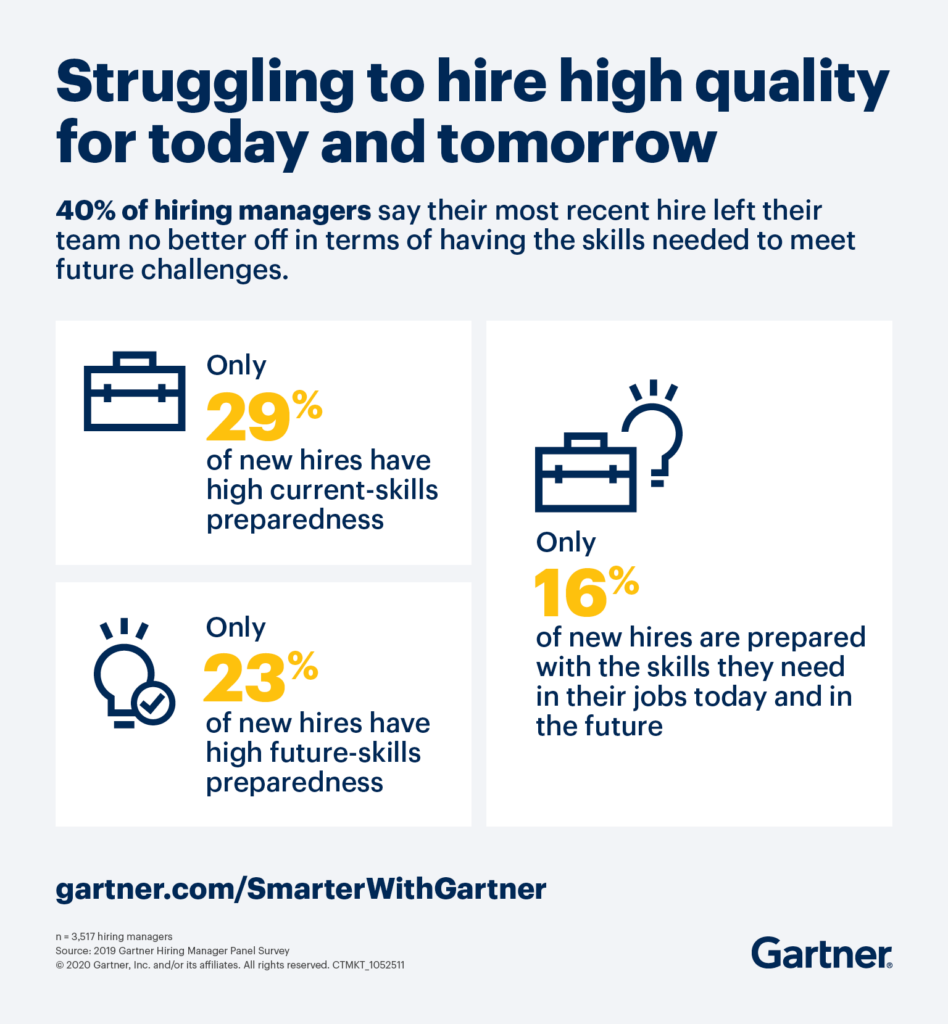
These days, many companies prioritize work assignments over interviews , as the typical interview process is outdated. Interviews and CVs alone don’t help the hiring team explore a candidate’s actual abilities. Why? Well, firstly, candidates sometimes exaggerate their qualifications on CVs. Plus, a potential candidate could be great in an interview scenario but terrible at the actual job.
Another reason interviews are passé is that they can open up the hiring team to potential cognitive bias (hiring someone very similar to you). This might seem kind of nice, but in the end, you’ll have less diversity if everyone you hired was a mini-me, right?
Yet, interviews do have an important role to play in the hiring process. But not right in the beginning, necessarily. Shifting the interview portion further down the hiring process steps helps companies focus on quality candidates rather than the search for quality candidates. They could rather confirm the technical fit through skills assessments and then dig deeper during the second interview.
According to HBR, prioritizing homework assignments over interviews can help recruiters better match true competency with the job requirements:
One of us (Jeff) spent several years hiring writers for our firm. He used a scenario-driven writing assignment, administered after a short introductory call, to assess skills. Many publications use writing or editing tests for job candidates, but Jeff approached the task more analytically than most: After receiving the assignment, he conducted a follow-up conversation to understand not just what was on the page, but the candidate’s choices in crafting it. Not only did this give us a sense of how a candidate would perform, but they got a much better sense of the job itself, as we related elements of the task to actual role expectations. By using the same exercise repeatedly, it also built a database of responses over time, a positive feedback loop to better assess the next candidate. Geoff Tuff, a principal at Deloitte Consulting LLP – Harvard Business Review
The real benefits are that work assignments and skills assessments paint a truer picture and can also:
- help identify the best person for the job
- reveal an applicant’s work ethic
- reduce the risk of selecting candidates that have lapsed technical skills (especially with the rapid evolution of technology)
- are easy to deploy at scale – you can narrow down the number of applicants from 500 to 50 to save the hiring team loads of time
- help organizations draw in non-typical but strong candidates that broaden the team’s diversity, equity & inclusion
- reduce the risk and cost of a bad hire

What do candidates gain from completing homework assignments?
Job seekers may not often feel enthusiastic about interview assignments. And we get it. People are busy juggling so many things in their day to day that adding one more can feel overwhelming. But those who look at the bigger picture see it as an opportunity to shine.
Work assignments are a foolproof way for job seekers to demonstrate their skills and expertise . And if candidates happen to have any gaps in their experience, they can still demonstrate their aptitude through an online assignment.
It’s also an easy way for candidates to show they’re truly interested in the position and the employer and stand out from the crowd of other applicants.
Not only do these task projects give them a peek into their potential day-to-day responsibilities , but it’s also a window into whether the role is a good fit for them in the long run .
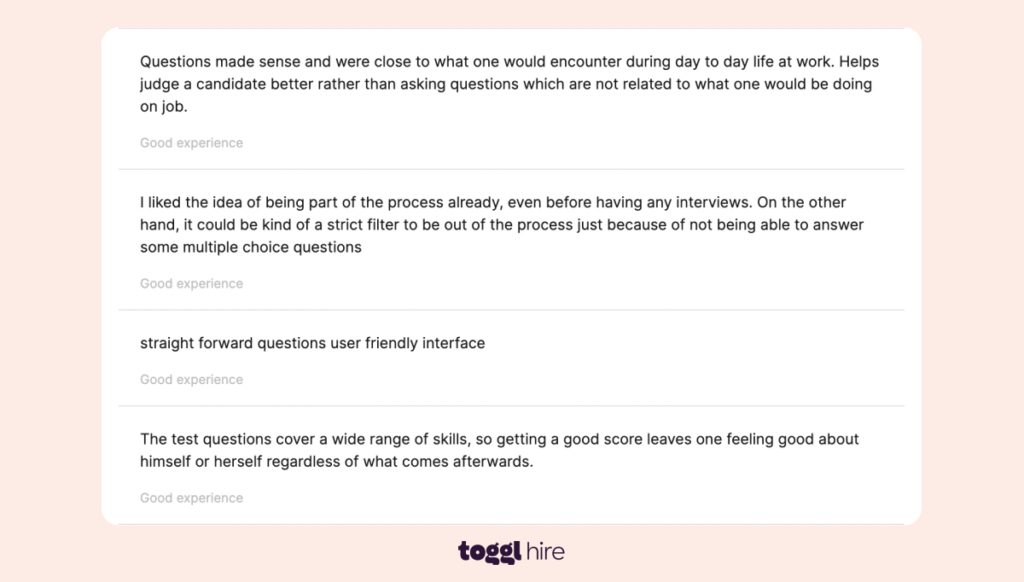
If they find the task takes too long or that the topic or sector is dryer than toast – they should put their sights elsewhere. But if it’s all systems go – then they’ve already got a head start on producing what’s needed for the role.
5 Types of take-home interview assignments
Take-home interview assignments are a popular choice for assessing technical and creative candidates. But now companies are seeing the benefits for other roles too.
Three things that hiring managers should consider for all these types of interview assignments:
- Letting candidates know about the test beforehand. That way, they’re not surprised and feel they’re starting off on the wrong foot.
- Automating everything they can in the testing process, so they don’t leave candidates high and dry in between lengthy hiring phases.
- Using the data they gain from these tests and candidate feedback to update their hiring process.
And now, onto the examples of homework assignments.
#1 Basic skills screening
Quick skills screening tests as a pre-qualifying step can help reduce the volume of applications without any manual effort. That means no manual resume screening or individual candidate feedback.
As applicants get instant feedback via skills test results (they either pass the required score threshold and move on or stop there), recruiters and hiring managers benefit in three major ways: 1) they save hours of their time by automating CV screening; 2) they can easily identify qualified applicants who should move to the interview stage; 3) they ensure a great candidate experience with modern skills-based hiring practices.

Good practices:
Keeping the tests short and sweet to respect candidates’ time and effort. We’d recommend 15 or 20-minute assessments at the kickoff. However, it’s important to ensure the tests are hard, so they actually act like a quality filter for your candidate pipeline.
Bad practices:
Focusing too much on theoretical, bookish questions that make the test feel like a school exam can harm your test completion rate and prevent great candidates from submitting their applications. Additionally, making the screening tests too long or too intrusive (e.g., taking snapshots through the computer camera) can create an unnecessary barrier and reduce your chances of sourcing top-quality people.
#2 Pre or post-interview coding challenges
While a job interview can help hiring managers assess interpersonal skills, such as communication , teamwork, or motivation, it’s not the best medium for evaluating hard skills . Online coding tests help the hiring team select technically capable developers that can contribute to the business.
A recruiter would typically source candidates with the right programming languages listed on their profile or resume. And then, it’s the hiring manager’s responsibility to work out if the applicant has what it takes to write good code. Easier said than done!
That’s why a coding assessment as a homework assignment has become the norm in tech hiring, and most developers are willing to take them on.
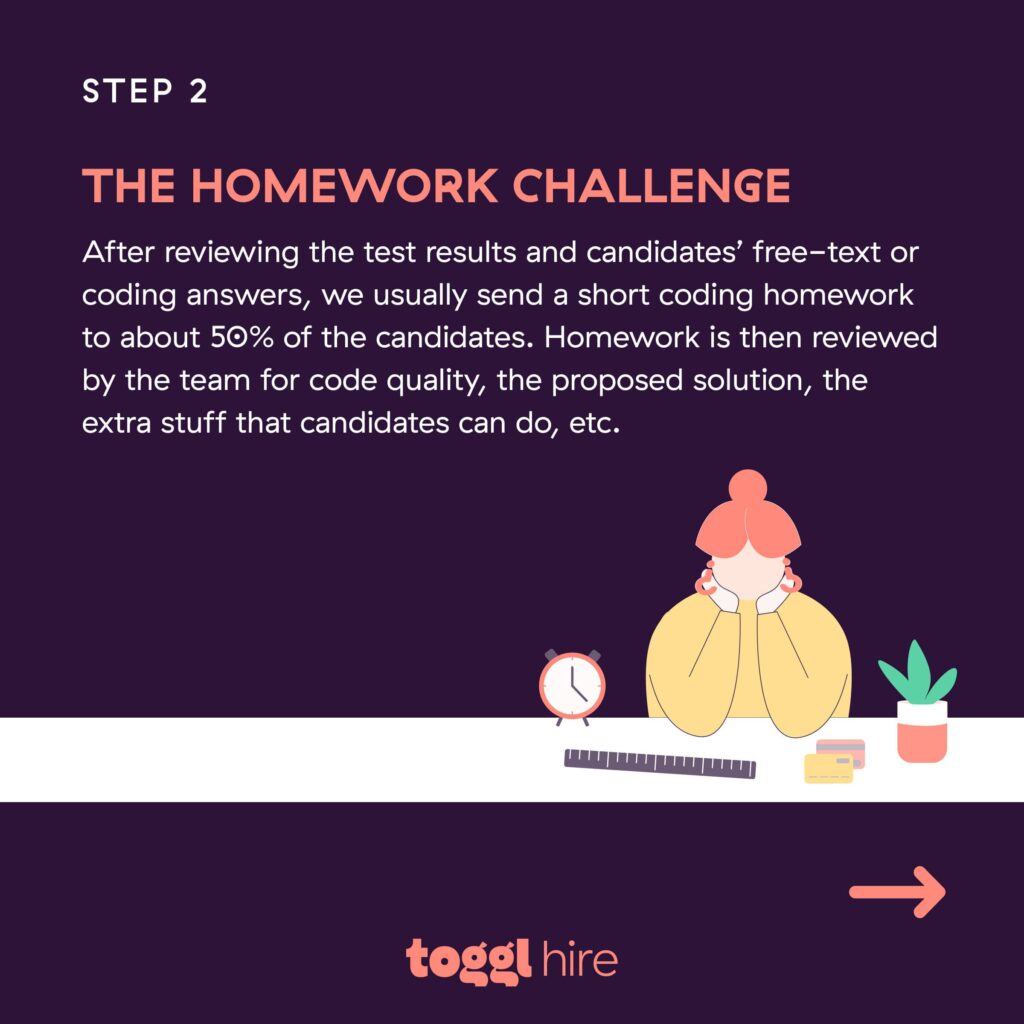
Remember, though; candidates don’t owe you free work. Your approach to designing a coding test will determine whether people continue in the hiring process or drop off.
First of all, decide what you want to assess and why. If you’re hoping to ascertain a candidate’s troubleshooting and problem-solving skills, time-boxing the assignment wouldn’t work to your advantage. The candidate can always use the ‘lack of time’ as an excuse for lower-quality work.
Another thing to remember is to set the test at the right skill level, depending on whether it’s a junior, intermediate or advanced role.
Testing skills that are nice to have or don’t match the role is a common mistake. Focusing on too many topics requires candidates to switch context from question to question – which is often confusing and tiring in such a short span of time.
Another issue employers run into is using clunky testing software that candidates need to figure out on the fly. If it takes effort to learn the platform or the platform doesn’t have the required features, developers will have to pay the price.

#3 Portfolio reviews and spec work during the job interview process
Ask any creative about their opinion on spec work, and you’ll likely hear that it sucks. And there are good reasons for graphic designers, writers, and other creatives to hate this kind of work – why should they commit to the project without any promise of payment?
If you’re hiring a professional from the creative field, we highly recommend starting with a live portfolio review . That’s when a candidate can take the interviewer through specific portfolio examples and share the backstory and lessons learned from that project. With creative roles, it’s often the unique style and quirks alongside the technical skills that can help determine the best person for the job.
However, sometimes paid spec work is a much fairer and more accurate way of getting insight into a candidate’s skillset. For tasks that require a highly personalized approach or solution, going the freelance gig route can yield better results.
Inform candidates ahead of time that you’d like to review their portfolio during a live interview. This will give them time to prepare and update their work samples. Ask questions that relate to their portfolio, even if the current samples don’t match your brief – you want to understand their creative process and practices. For paid spec work, make time to discuss the brief in person and agree on a check-in schedule to ensure work progresses in the right direction.
Springing this on the candidate without any warning and expecting the work to be delivered on a short deadline is a questionable move. Even if you’re opting for paid spec work, bear in mind these tasks are often completed in a vacuum and should be evaluated through a less critical lens. And finally, the not-so-secret secret: most creatives are terrible at maintaining their portfolios up-to-date. Giving them the heads-up will increase your chances of selecting the right talent.
#4 Time-boxed homework assignments that go in-depth to evaluate candidates’ competence
This type of home assignment can take many forms – from asking a marketing professional to write a press release for a product launch that already happened to requesting a business analyst to extract key insights from a dataset.
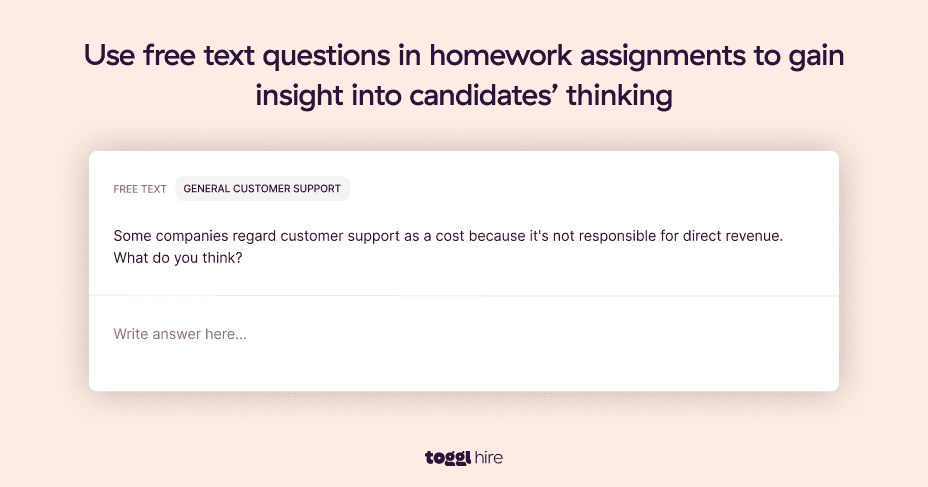
To ensure it’s not perceived as free work, time-boxed assessment projects often focus on real-world business problems that have been solved internally. This way, you can benchmark candidates’ work against your internal quality standard and reassure candidates of your intentions. The sole purpose of interview assignments is to confirm candidates’ technical fit in an efficient manner.
Keep the topic or assignment relevant to the role, and limit the necessary time it’ll take to complete to about 2-3 hours. Remember that the clarity of your brief will largely determine the quality of the deliverables, so be specific about your expectations.
Expecting someone to take 5-10 hours out of their busy schedule for an unpaid assignment is unrealistic.
#5 Paid projects during the interview process
Interviewing is exhausting for both the candidate and the interviewer. So it’s unsurprising that paid interview assignments have been gaining in popularity in recent years.
As a hiring manager, would you rather spend hours of your time interviewing candidates to filter out the bad apples or use the job interview as a way to get to know potential hires?
Homework assignments are exactly that – a simple, efficient method for spotting A-level candidates with the right skills for the job.
As you confirm the technical fit before the interview, both parties can focus on aligning on other important factors, such as the organizational fit , team culture, and manager expectations.
However, many employers have realized that the sentiment around homework assignments has shifted from acceptable to immoral, as applicants began calling assignments ‘free work’. Research shows that drop-off rates increased when candidates were asked to complete a take-home assignment.

Enter paid homework projects.
The perfect combo of practical competency assessment and paid work. Since the candidate receives compensation for their time, these types of assignments can be longer and more complex.
Anything from analyzing the growth funnel to tackling a programming challenge to designing an effective product onboarding experience can serve as a homework assignment idea.
What’s important to note is that these kinds of work assignments allow employers to get a glimpse into a candidate’s work ethic , thinking process, time management, and many other skills that are impossible to assess during the interview process.
If you’re paying for their time, treat them like consultants: provide access to important information, answer their questions and connect them with the right people internally. And be sure to outline the recruitment process at the very start; not everyone will happily take on a bigger commitment project, even when it’s paid.
As a hiring manager, stay in touch throughout the recruitment process to lay the foundations for a good working relationship. Provide clear requirements and timelines to reduce stress, and don’t forget about fair compensation – going below the market rate is disrespectful.
A great way to cause unnecessary stress is to ask candidates to present to a large audience or high-level execs they would never work with on a day-to-day basis.
Be sure to provide a clear agenda for the presentation call ahead of time and prep your interview panel for follow-up questions.

The work assignments and interview process windup
Work assignments are a good thing for companies and candidates alike. The result is like the difference between speed dating and a real dinner and a first date. Yes, they’re both exciting, but in the case of hiring, you need to hire someone that can demonstrate they have the right skills. The cost of hiring the wrong candidate is just too high for companies.
To find truly interested candidates, who have the right aptitude, introduce your team to the benefits of work assignments. You’ll save both parties loads of time and the hassle of a dragged-out interview process and other redundant hiring steps.
If you’re ready to explore how to transform your business’ hiring process from a time-consuming to a slick candidate pipeline, we leave you with five simple tips on designing an effective homework assignment.
5 simple tips for designing a great homework assignment:
- Replace resume screening with basic skills screening. Start the sifting process early with a quick skills screening test . This will weed out the bad eggs and leave you with a selection of good potential candidates.
- Make your assignment brief and easy to understand, and explain the key outputs you expect.
- Match the level of the homework assignment to the level of the role. Unrealistic tasks will only scare people off.
- Don’t request candidates to solve super-specific business problems. Make the assignment generalized, not based on a super specific problem your business is experiencing.
- Give the candidate a chance to show and tell. That way, you get insight into their thought process, presentation skills, and even emotional intelligence when their viewpoint is challenged.
Have a peek at our Test Library for more assignment ideas, and good luck!
Juste loves investigating through writing. A copywriter by trade, she spent the last ten years in startups, telling stories and building marketing teams. She works at Toggl Hire and writes about how businesses can recruit really great people.
Subscribe to On The Clock.
Insights into building businesses better, from hiring to profitability (and everything in between). New editions drop every two weeks.
You might also like...
Related to Talent Acquisition

The Top 16 Candidate Assessment Tools in 2024
Take a peek at our most popular categories:
Browser does not support script.
- Departments and Institutes
- Research centres and groups
- Chair's Blog: Summer Term 2022
- Staff wellbeing
Take-home assessment

What do we mean when we say ‘Take-home assessment’?
Take-home assessment require students to complete a task and submit their work within a strict time limit while working off-campus. Students are allowed to consult their own notes, course texts and other materials. Electronic routes (most commonly Moodle ) can be used across the assessment life-cycle – from electronic submission to electronic feedback and return of grades. The overall condition – students working unsupervised, with a time limit – can include various methods of assessment such as case studies, take home exams and projects. Assessment tasks, and time limits, can be devised to serve the course requirements. The timetabling of take-home assessments is the responsibility of the department; therefore measures should be put in place to ensure that that students are not unduly burdened with a number of assessments at the same time. Scheduling take-home assessment requires an awareness of various factors, including requirements for accessible assessment; responsibilities at home; part-time employment, and a consideration of other submission deadlines (see ‘ Accessible assessment ’ for more detail).
What are assessment conditions?
It is useful to bear in mind that what is sometimes referred to as an assessment method is, in fact, only the condition in which the assessment takes place and thus only one of several choices to be made in assessment design. The term ‘take-home assessment’ mainly describes the conditions under which an assessment will take place – it does not describe the method by which the students will be assessed. Assessment conditions establish the parameters of assessment but within each of these assessment conditions a number of assessment methods may be used. Reflecting on the purpose, timing and assessment mix should help with decisions regarding assessment conditions.
Advantages of take-home assessment
- The time period, and the ability to access materials, may allow students to better demonstrate their knowledge, abilities and use of sources.
- If the course’s learning outcomes emphasis higher order cognitive skills (argument, application, comparison, critique etc.) and the use of sources, a take-home assessment may allow for a more authentic assessment of these.
- For some programmes, take-home assessments more closely resemble the work activities where students’ knowledge and skills will ultimately be used.
- Can require fewer adjustments for individual students. For instance, take-home assessments can accommodate students who would need additional time in a traditional exam, and students can use their own computer equipment with support software.
- When submissions are word-processed and electronically submitted they are more legible than hand-written scripts, and can be marked by two academics simultaneously. With student permission, past answers can be anonymised and shared as exemplars.
Challenges of take-home assessment
- Students need to provide their own workspace and computer equipment.
- Adequate support should be available (both technical, and for clarification in case of factual errors in questions etc.) for the duration of the take home assessment.
- Take-home assessments carry an increased risk of unauthorised collaboration between students.
How students might experience take-home assessment
Students may find a take-home assessment less stressful than a traditional exam (see Weber, McBee and Krebs, 1983) for various reasons (familiar location, access to materials, additional and more flexible time). Different formats and lengths of take-home assessment might confuse students; therefore each assessment task should be accompanied by clear guidance. The risk of unauthorised collaboration can affect student perceptions of fairness. If take-home assessments are being considered for an existing course it might be worthwhile consulting students on the course to gauge enthusiasm and to identify concerns or misconceptions.
Reliability, validity, fairness and inclusivity of take-home-assessment
Questions should be designed to demand higher order activities from students, and checked by colleagues for possible misinterpretation (and approved by the department and external examiners if required by departmental practice). Criteria should be established in advance and shared with students . Written instructions should be carefully prepared so as to minimise student stress and queries during the assessment period. These should include: word-count (setting a word-count can communicate expectations, help with parity and keep marking workload reasonable); preferred referencing systems, and the policy for late submissions. Formative assessment should help prepare students for the summative take-home assessment work, in terms of question type and assessment method. Take-home assessment can help reduce the need for specific adjustments for individual students. However, consideration should still be given to this (see ‘Accessible assessment’ for more detail).
How to maintain and ensure rigour in take-home assessment
Submissions should be double marked or moderated in accordance with departmental practice. The intended learning outcomes of a course are often written such that they reflect what students will have learned by the end of the course; however, as take-home assessments are timetabled by the department, students may be assessed during the term. Therefore the marker should be careful to assess them in relation to what they are expected to know at that particular point in time. Individual markers should take steps to avoid the problems which affect batch marking, such as the 'halo' effect where one or two positive characteristics of a student overly influence the marker.
How to limit possible misconduct in take-home assessment
Changing questions each year prevents previous cohorts of students from sharing their work. Requiring students to work with a recent source, or with specific course content and activities, limits opportunities for finding pre-existing content and tasks can be linked to a previous completed assessment to prove authorship (and to create a developmental feedback process). If students are not permitted to consult staff members during the assessment period, then it is important to check that all departmental staff, GTAs, and LSE LIFE are aware of this, and know both the assessment timing and (ideally) the questions. Online submission can include a text-matching tool such as Turnitin and students can be asked to submit a declaration of academic integrity (or similar) with their completed scripts. Teachers can also contact the Eden Centre Eden Digital team for further guidance if they are planning on setting a take-home assessment using technology.
Accessible assessment in take-home assessment
There are practical design issues to consider when using take-home assessments to assess students who are either physically impaired; have mental health difficulties; specific learning differences, or Autism Spectrum Condition. Wherever possible design issues should be addressed in the initial course design phase. The Accessible Assessment area of this toolkit provides further information about how this might be achieved. This is a guide and should be treated as such. In all cases the experiences of individual students can be diverse. You should always consult the student’s inclusion plan as well as speaking to the student directly. The discussion in this section is drawn on the work of the Inclusive Practice community at Sheffield Hallam University who we wish to acknowledge and thank.
Physically impaired students
A physical impairment may not always be visible and may include, for example, students who experience severe pain after a prolonged amount of time writing or sitting. Where this is the case the student may need longer to complete the assignment. Teachers should also consult the student’s inclusion plan to see if there are any comments regarding specific support. Students working at home are likely to have their own resources and structures for support but this should not be taken for granted. Students who have just moved into new accommodation may be awaiting the delivery/installation of equipment and it is a good idea to double-check with students that they will be able to complete the assessment.
Students with specific learning differences (SpLD)
When writing, students with SpLD can experience difficulties in sequencing and ordering information. Reading can be slow or they can find that they go over the same information several times without realising the error. Searching for the right word can also interrupt the ‘flow’ of the essay and result in poor expression. Strategies such as providing students with deadline reminders or breaking large chunks of work down into smaller pieces with associated deadlines will aid with time management. Providing students with the opportunity to have regular meetings with their teaching/support staff and the opportunity to submit essay/dissertation outlines can be useful. This will also help students to avoid producing ‘wordy’ assignments, which although containing the correct information, do not answer the questions, or veer from the topic as they have misread or overlooked key words in the question. Teachers should also ensure that they mark work for content and understanding rather than structure or standard written English, except where these may significantly impede meaning. Providing reading lists in advance is good practice so all students can have the opportunity to start reading new material early.
Students with Autism Spectrum Condition (ASC)
The term ‘Autism Spectrum Condition’ (ASC) is used to describe the range of the autism spectrum, including Asperger syndrome. Word limits should be set but also explained to students with ASC. Teachers should also made explicit what a finished essay/report/dissertation should ‘look’ like. This should include the format as well as content, and what is expected from an academic piece of work of this kind. Students should have the opportunity to be able to discuss and demonstrate progress with their teacher/support staff. Similarly, if possible, students should have the opportunity to discuss drafts of their work. Teachers should be aware however that some students with ASC may lack the language required for articulating feelings and not think to ask for help, teachers should therefore be proactive in providing opportunities for students to ask for such help. It may be necessary to be explicit about what is reasonable when asking for help, being clear about when and where to meet, how long can be devoted to the meeting and listing the topics that will be covered in the meeting in writing.
Students with mental health difficulties
Students with mental health issues may need help to break down large projects into small chunks with associated deadlines. Students can be supported by encouraging them to draw up a timetable so that they can best organize their time. Where students have difficulty with sustained concentration it might also be helpful to encourage them to include time for rest breaks in this timetable. Where possible, and if appropriate, additional time should be allowed, as per normal course procedures to complete the written work. This is because the side effects of medication can include drowsiness and difficulty in concentration. Teachers should be aware that over the duration of writing a take-home assessment the student’s mental health difficulties may fluctuate with ‘good’ and ‘bad’ periods.
Implementing this condition at LSE
If you’re considering using take-home assessment, this resource offers more specific information, pedagogic and practical, about implementing the method at LSE. This resource is password protected to LSE staff.
Back to Assessment conditions

Back to Toolkit Main page

Contact your Eden Centre departmental adviser
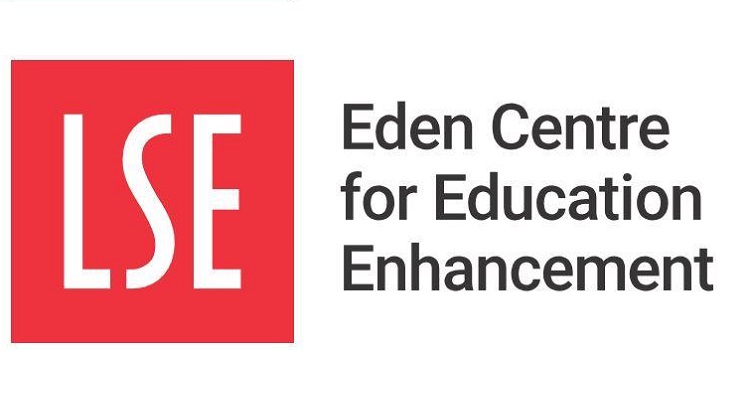
If you have any suggestions for future Toolkit development, get in touch using our email below!
Email: [email protected].
Navigation Menu
Search code, repositories, users, issues, pull requests..., provide feedback.
We read every piece of feedback, and take your input very seriously.
Saved searches
Use saved searches to filter your results more quickly.
To see all available qualifiers, see our documentation .
- Notifications You must be signed in to change notification settings
trongkhanh083/back-end-take-home-assignment
Folders and files.
| Name | Name | |||
|---|---|---|---|---|
| 1 Commit | ||||
Repository files navigation
Backend take-home assignment.
Our company is building a LinkedIn-like application for real-estate agents. As a backend engineer, you are building & maintaining a few endpoints that enable our users to (1) send, (2) accept, and (3) decline friend requests, as well as (4) view their friends' profiles.
This take-home assignment aims to assess the followings:
- Your competence in Javascript/TypeScript & their ecosystem
- Your competence in SQL
- Your ability to follow instructions
- Your ability to adapt to a new codebase
- Your ability to read documents
- Your ability to "Google" & "Stackoverflow" your way to the answers
- Clone the repo to your computer
- Run yarn install
- Run yarn db:push
- Run yarn test
NOTE: Though not compulsory, it's highly recommend that you use VSCode, with the following Extensions:
- ESLint (enabled)
- Prettier (disabled)
Instructions
There are only 2 tables in our applications: users and friendships . You can view their structures in src/server/db/schema.prisma .
You will be strictly working on & making changes to the following files below. Do not create new files or make any changes to any other files in the repo.
- src/server/api/routers/friendship-request-router.ts
- src/server/api/routers/my-friend-router.ts
- src/server/tests/friendship-request.test.ts
There are 4 questions in total. Though not enforced, we highly recommend that you do them in order. There are further instructions embeded in the questions.
NOTE: if the links to the questions do not work, you can find them in the following files
After you finish the test, do a self-assessment by completing the checklist in the Checklist section below.
Finally, publish the finished repo to your Github, then send the url to the repo via email to [email protected] and [email protected]
- Attempt Question 1
- Attempt Question 2
- Attempt Question 3
- Attempt Question 4
- Finish Question 1
- Finish Question 2
- Finish Question 3
- Finish Question 4
- Run yarn lint with no errors
- Run yarn type-check with no errors
- Pass test Question 1 / Scenario 1
- Pass test Question 1 / Scenario 2
- Pass test Question 2 / Scenario 1
- Pass test Question 3 / Scenario 1
- Pass test Question 3 / Scenario 2
- Pass test Question 4 / Scenario 1
- Pass test Question 4 / Scenario 2
- TypeScript 89.0%
- JavaScript 10.8%

IMAGES
VIDEO
COMMENTS
In fact, the take-home assignment should actually be a huge boost to your confidence. When you're asked to complete one, it's a clear indication that the hiring manager's excited to see how you'd tackle a problem similar to one the organization's been dealing with. In other words, the company's struggled with the issue in the past ...
5 thorough examples of great take-home assignments. Now that you better understand the how, the when, and the why of take-home assignments, we'll show you five examples. The example take-home assignments will cover tasks for: Developer - fixing a broken site. Product manager - redesigning a feature.
A take-home assignment is a hands-on task they can do on their own time in the comfort of their home. This can take some of the pressure off and let the candidate showcase their skills well. Cons of a take-home assignment. Before you decide to implement take-home assignments, consider the following challenges: 1. Time-consuming
By using tests to assess job candidates, recruiters can now "remove some of the human bias and get more objective information" when making hiring decisions, Hosage said. "Recruiting has always ...
Let's take a look at 9 key points to remember for you to master Take-Home Assignments: 1. Decoding the Assignment. Deciphering the assignment begins with a meticulous examination of the brief provided. This involves dissecting the problem statement, objectives, evaluation criteria, and the anticipated deliverables.
The take-home assessment interview-also called the working interview-has several pros and cons. Different from an interview skills test, the take-home assignment may include payment.This article will tell you what to expect and help you prepare if you come up against this type of interview. The interview can be an extremely nerve-racking ...
A take-home assignment (take-home or takehome) is a coding task given to technical candidates to complete on their own time. Candidates are typically given a day to several days to complete a take-home. controversy Take-homes are controversial. While there are many pros for the companies assigning them, they are less valuable in terms of the candidate experience.
In the first installment of our smart homework series from author & teaching consultant Rick Wormeli, he made the case for take-home assignments that matter for learning and engage student interest.In Part 2, Rick suggested 13 guiding principles to help teachers create homework challenges that spark deeper learning. In this final article, Rick suggests some good ways to assess homework and ...
Interviewing for a new job requires you to prove your skills, qualifications and personality aligns with what a company wants. Many hiring managers now look for ways to assess a candidate's technical abilities before giving them a job offer.In this article, we discuss what a job interview assignment is, the do's and don'ts of completing a job interview assignment and examples of job interview ...
December 20, 2018. by. Lewis Lin. There's a new trend in product management interviews: the take home assignment. Take home assignments can vary in their format. They can either be: Written tests that revolve around hypothetical questions. Written tests that revolve around case questions. Written tests that revolve around behavioral questions.
I do share the frustrations of take-home assignments though. Prior to getting this job, I've completed 5-6 take-home assignments and moved past that interview stage after only 1 of them. Same deal, open-ended assignments, no feedback on what I did right or wrong afterward despite me asking, generic rejection emails if even that.
Common Errors. Here are some common errors that PM candidates face during take-home assignments: Misunderstanding the goals of the assignment. Spending too much on wireframing as opposed to establishing a clear vision. Putting too much emphasis on the formatting of the presentation as opposed to the content. Not being succinct.
5 Types of take-home interview assignments. Take-home interview assignments are a popular choice for assessing technical and creative candidates. But now companies are seeing the benefits for other roles too. ... That's why a coding assessment as a homework assignment has become the norm in tech hiring, and most developers are willing to take ...
%PDF-1.7 %µµµµ 1 0 obj >/Metadata 189 0 R/ViewerPreferences 190 0 R>> endobj 2 0 obj > endobj 3 0 obj >/ExtGState >/Font >/ProcSet[/PDF/Text/ImageB/ImageC/ImageI ...
What is a take-home assignment? Similar to the coding test for Software Engineer, a take-home assignment is a preliminary filter that helps recruiters find candidates with the best skills/commitment to proceed with the next rounds of interviews. It usually comes after the screening round and before the first technical interview.
Take-home assessment require students to complete a task and submit their work within a strict time limit while working off-campus. Students are allowed to consult their own notes, course texts and other materials. Electronic routes (most commonly Moodle) can be used across the assessment life-cycle - from electronic submission to electronic ...
In my 4 years of doing these take-home assignments, I've raised my take-home → onsite conversion to over 90% without full-time work experience. The rest of this post covers strategies that have worked well for me to crush these assignments and get to the onsite interview, and I hope you find them valuable as well. 2 Kinds of Data Take-Homes
2. Students must follow steps to open the exam, download questions, complete answers in Word or on paper and scan/save as a PDF, and submit the file by clicking "Add Submission" and checking requirements before the deadline. 3. The video guide shows the full submission process for take-home assessments.
After you finish the test, do a self-assessment by completing the checklist in the Checklist section below. Finally, publish the finished repo to your Github, then send the url to the repo via email to [email protected] and [email protected]
plete a Take-Home exam assessment:Open the. ake-Home (Assignment) assessment.Download the question paper and note any additional information provided, such. s the proctoring tool to be used.Complete the Take-Home. assessment in MS Word or on paper.Note: MS Word documents need to be saved as PDF documents, and paper-based answers must be sc.
The assignment overview provides some background on the task and a short description of what they expect you to do with the dataset. For example, in my take-home assignment for a data science position in Deliveroo, the task was to analyze the performance of their RGR (Rider Gets Rider) referral program compared to other marketing channels.
Take-home assessment #7. 12. Week 10: Theme week #2. 12.1. Project kick-off. 13. Week 11: Effectful programming. 13.1. Take-home assessment #8. 14. Week 12: Introduction to algorithmic analysis. 14.1. ... In grading these assignment, we will look for the following for each level. We may also identify other characteristics that move your work ...